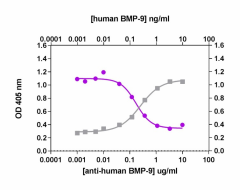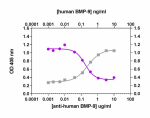- Clone
- A16035H (See other available formats)
- Regulatory Status
- RUO
- Other Names
- Bone morphogenetic protein 9 (BMP9), growth differentiation factor 2 (GDF2)
- Isotype
- Mouse IgG2b, κ
- Ave. Rating
- Submit a Review
- Product Citations
- publications

-

Recombinant human BMP9 (Cat. No. 553102) induces alkaline phosphatase in ATDC5 mouse chondrogenic cell line in a dose dependent manner (black circles). Anti-human BMP9 monoclonal antibody (clone A16035H, purple circles) neutralizes the production of alkaline phosphatase in ATDC5 cells induced by BMP9 (2 ng/mL). The ND50= 0.05 - 0.25 µg/mL.
| Cat # | Size | Price | Quantity Check Availability | Save | ||
|---|---|---|---|---|---|---|
| 611703 | 100 µg | £185 | ||||
| 611704 | 1 mg | £490 | ||||
Select size of product is eligible for a 40% discount! Promotion valid until December 31, 2024. Exclusions apply. To view full promotion terms and conditions or to contact your local BioLegend representative to receive a quote, visit our webpage.
BMP9 was initially isolated from fetal mouse liver cDNA libraries. The human and mouse proteins share 84% identity. They are part of the bone morphogenetic protein (BMP) family of proteins, which are members of the TGF-β superfamily and play a key role in skeletal development, bone formation, and stem cell differentiation. BMP9 is one of the most osteogenic factors of the family. It is sinthetized by hepatocytes and intrahepatic biliary epithelial cells and circulates in plasma as an unprocessed inactive form that can be further activated by furin, and as a mature and fully active form as a complex associated to its prodomain. BMPs signal through heterotetrameric complex receptors, which include four type I receptors (ALK1, ALK2, ALK3 and ALK6) and three type II receptors (BMPRII, ActRIIA and ActRIIB). BMP9 and -10 bind to ALK1 (mainly expressed in endothelial cells). BMP9 inhibits the proliferation of endothelial cells induced by basic FGF and the VEGF-stimulated angiogenesis by its binding to ALK1. BMP9 also binds to ALK2 in primary myeloma cells, and this binding can be inhibited by membranal or soluble endoglin (accessory receptor for the TGFβ family). BMP9 activity is inhibited by crossveinless2 (CV2), a member of the chordin family and extracellular regulator. BMP9 induces CV2 expression in endothelial cells and in a negative feedback loop inhibits its own activity by the binding of CV2 to BMP9, and consequently inhibits its binding to ALK1. BMP9 and -10 possess tumor suppressing activity in breast and prostate cancer; BMP9 as well induces apoptosis in primary myeloma cells. In contrast, autocrine BMP9 signaling induces proliferation of ovarian and liver cancer cells.
Product DetailsProduct Details
- Verified Reactivity
- Human
- Antibody Type
- Monoclonal
- Host Species
- Mouse
- Immunogen
- Recombinant BMP9
- Formulation
- 0.2 µm filtered in phosphate-buffered solution, pH 7.2, containing no preservative.
- Endotoxin Level
- Less than 0.01 EU/µg of the protein (< 0.001 ng/µg of the protein) as determined by the LAL test.
- Preparation
- The Ultra-LEAF™ (Low Endotoxin, Azide-Free) antibody was purified by affinity chromatography.
- Concentration
- The antibody is bottled at the concentration indicated on the vial, typically between 2 mg/mL and 3 mg/mL. Older lots may have also been bottled at 1 mg/mL. To obtain lot-specific concentration and expiration, please enter the lot number in our Certificate of Analysis online tool.
- Storage & Handling
- The antibody solution should be stored undiluted between 2°C and 8°C. This Ultra-LEAF™ solution contains no preservative; handle under aseptic conditions.
- Application
-
Neut - Quality tested
- Recommended Usage
-
Each lot of this antibody is quality control tested by neutralizing activity. The ND50 is 0.05 - 0.25 µg/mL. It is recommended that the reagent be titrated for optimal performance for each application.
- RRID
-
AB_2728466 (BioLegend Cat. No. 611703)
AB_2728466 (BioLegend Cat. No. 611704)
Antigen Details
- Structure
- Homodimer
- Distribution
-
Hepatocytes, non parenchimal cells of the liver, endothelial, stellate cells, osteosarcoma cells.
- Function
- Induces osteogenesis, chondrogenesis, differentiation of cholinergic neurons, and regulates glucose metabolism.
- Interaction
- Endothelial cells,microvascular endothelial cells, prostate cancer cells, ovarian cancer cells, osteosarcoma cells, primary myeloma cells.
- Ligand/Receptor
- Actvin receptor-like kinase- ALK-1 and ALK-5 in endothelial cells; ALK1 and BMPR-II in endothelial cells; ALK-1 and ALK-2 in mesenchymal stem cells; ALK2 and BMPR-II in myoblasts; ALK1 and endoglin in glioblastoma cells. Endoglin (CD105).
- Cell Type
- Endothelial cells
- Molecular Family
- Cytokines/Chemokines, Growth Factors
- Gene ID
- 2658 View all products for this Gene ID
- UniProt
- View information about BMP-9 on UniProt.org
Related Pages & Pathways
Pages
Related FAQs
- Do you guarantee that your antibodies are totally pathogen free?
-
BioLegend does not test for pathogens in-house aside from the GoInVivo™ product line. However, upon request, this can be tested on a custom basis with an outside, independent laboratory.
- Does BioLegend test each Ultra-LEAF™ antibody by functional assay?
-
No, BioLegend does not test Ultra-LEAF™ antibodies by functional assays unless otherwise indicated. Due to the possible complexities and variations of uses of biofunctional antibodies in different assays and because of the large product portfolio, BioLegend does not currently perform functional assays as a routine QC for the antibodies. However, we do provide references in which the antibodies were used for functional assays and we do perform QC to verify the specificity and quality of the antibody based on our strict specification criteria.
- Does BioLegend test each Ultra-LEAF™ antibody for potential pathogens?
-
No, BioLegend does not test for pathogens in-house unless otherwise indicated. However, we can recommend an outside vendor to perform this testing as needed.
- Have you tested this Ultra-LEAF™ antibody for in vivo or in vitro applications?
-
We don't test our antibodies for in vivo or in vitro applications unless otherwise indicated. Depending on the product, the TDS may describe literature supporting usage of a particular product for bioassay. It may be best to further consult the literature to find clone specific information.
Other Formats
View All BMP-9 Reagents Request Custom Conjugation| Description | Clone | Applications |
|---|---|---|
| Ultra-LEAF™ Purified anti-human BMP9 (GDF2) | A16035H | Neut |
Compare Data Across All Formats
This data display is provided for general comparisons between formats.
Your actual data may vary due to variations in samples, target cells, instruments and their settings, staining conditions, and other factors.
If you need assistance with selecting the best format contact our expert technical support team.
-
Ultra-LEAF™ Purified anti-human BMP9 (GDF2)

Recombinant human BMP9 (Cat. No. 553102) induces alkaline ph...
 Login / Register
Login / Register 








Follow Us